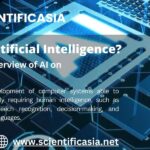Think about the best doctor you have ever visited. Now imagine giving that doctor the power to read a million patient charts in one minute. That is the true promise of bringing AI in healthcare.
This technology is the biggest game-changer in medicine right now. It is moving us from waiting and reacting to sickness to predicting and preventing it. By allowing smart machines to handle huge amounts of data, doctors can focus on what matters most: you, the patient.
And we are seeing major improvements in care quality, cost reduction, and medical safety across the board.
What Is AI in Healthcare?
Artificial intelligence in healthcare means using computer smarts to do tasks that typically need human brains. This includes looking at complex medical records, reading X-rays, and even helping to find the best medicine for a sickness.
AI takes huge amounts of patient information—like blood test results, heart rate data, and past doctor notes—and learns from it.
Then, it uses what it learned to give doctors practical, fast advice. It is a powerful assistant that helps doctors make better decisions quickly.
Core AI Powered Technologies – Machine Learning, NLP, and Deep Learning
The ability of AI for healthcare to work depends on several key computer technologies. These tools let the computer process and truly understand medical facts.
- Machine Learning (ML): This is the basic engine of AI. ML algorithms learn from patterns in old patient data. They do this to make good guesses about what will happen next, like predicting a patient’s risk for heart disease.
- Natural Language Processing (NLP): This lets computers read and understand human language. In a busy clinic, NLP can quickly scan thousands of doctors’ notes and research papers. This saves staff a lot of time on paperwork.
- Deep Learning (DL): This is a very advanced type of ML. It uses layers of complex computer networks to look at hard-to-read, unstructured data. DL is fantastic at scanning images. It is how doctors can use AI to look at an X-ray and spot a tiny problem a human eye might miss.
How AI Works in the Healthcare Industry
AI systems follow a clear, step-by-step path to deliver value inside the AI healthcare world.
- Gathering Data: AI first collects very large and different groups of patient data. Sources include electronic health records, data from smartwatches, and medical scans.
- Learning from Data: Special computer programs are trained on this clean data. They find patterns that connect patient information to certain health results.
- Making Predictions: Once trained, the AI model looks at new patient information. It quickly finds critical patterns and predicts things. For example, it might predict the risk of a patient needing to be readmitted to the hospital.
- Helping Doctors: The insights from the AI go straight to the doctors through software. This gives them real-time help right when they need to make a decision.
Key Applications and Use Cases of AI in Healthcare
The use of artificial intelligence in healthcare is spreading quickly. It offers smart solutions for everything from finding new drugs to improving patient visits.
Smart Diagnostics and Radiology
AI algorithms can look at medical images like X-rays and MRI scans faster than a person can. Urgent care doctors might miss a broken bone in up to 10% of cases. AI steps in to perform an initial scan, helping to prevent dangerous mistakes.
- Cancer Spotting: Deep Learning models can highlight tiny, subtle cancerous spots on scans. This helps doctors catch cancer earlier.
- Eye Disease Check: AI can look at eye pictures to quickly find early signs of diabetic retinopathy. This condition is a major cause of blindness.
Drug Discovery and Development
AI innovation is helping scientists create new medicines much faster and cheaper than before. It scans complex biology data to find new drug candidates quickly.
- Faster Trials: AI looks for the best patients to join new clinical trials. This makes the trials run quicker and more efficiently.
- New Drug Ideas: Companies have used AI to find a new drug candidate for a lung disease and get it into first-stage testing in under two years. That usually takes over four years with old methods.
Personalized Medicine and Treatment
AI takes a person’s genetic information, lifestyle, and full medical history. It then builds a treatment plan that is only for them. My personal insight is that this ability to treat the individual, not just the general sickness, is what makes AI revolutionary.
- Cancer Treatment: AI tools look at a patient’s genes to recommend the most effective, personalized cancer treatment plan.
- Medicine Doses: AI monitors real-time patient data to suggest exact medication amounts. This lowers the chance of bad side effects or dosing errors.
Top AI Solutions and Software in Healthcare
Many smart tools are now being used in the AI in healthcare industry.
| Solution Type | What it Does and Real-World Examples |
| Diagnostic Imaging Tools | They quickly flag critical findings in X-rays and scans. Examples include Aidoc and Infervision. |
| Virtual Assistants | Chatbots like Buoy Health check patient symptoms and help them find the right next step in care. |
| Drug Discovery Platforms | Tools like Atomwise use AI to screen millions of drug compounds quickly for research. |
| Clinical Support | Software that analyzes patient files to recommend the next best step for a doctor to take in treatment. |
What Are the Benefits of AI in Healthcare?
The benefits of AI in healthcare are huge. They bring big changes to patients, doctors, and hospitals.
Improved Diagnostic Accuracy and Speed
AI’s ability to check huge images and data files quickly means doctors can diagnose problems sooner. Earlier detection often means a better chance of beating a disease.
For breast cancer, finding it at Stage One gives a patient over 90% chance of five-year survival. AI helps achieve that goal.
Enhanced Operational Efficiency
AI manages many time-consuming paperwork tasks automatically. This frees up nurses and doctors. Tasks like appointment booking and filing insurance claims can be done by AI.
This reduction in administrative work is very important. It helps reduce the high stress and burnout that doctors feel every day.
Cost Reduction Through Predictive Analytics
AI uses predictive analysis to find patients who are at high risk of getting very sick before it happens. By stepping in early, doctors can stop expensive emergency room trips and hospital stays.
One study suggests that this smart use of AI could cut hospital operating costs by 4% to 10%.
Key Challenges and Limitations of AI in Healthcare
Even with all the good things, using artificial intelligence in healthcare has important challenges. These are the major pros and cons of AI in healthcare.
Data Privacy and Security Concerns
AI systems must handle huge amounts of secret patient information. Keeping this data safe from hackers and following rules like HIPAA is hard work.
If patient information gets out, people lose trust in the medical system. Strong security is always needed.
Algorithmic Bias and Fairness
AI models only learn what they are taught. If the training data comes mostly from one group of people (like one race or gender), the AI might not work well for others.
This is called algorithmic bias. It can lead to unequal care, like an AI being less accurate at diagnosing a skin condition on darker skin.
Lack of Explainability
Many advanced AI systems work like a “black box.” A doctor may not fully understand why the AI made a certain recommendation.
This lack of transparency makes it hard for a doctor to fully trust the system. If the AI makes a mistake, figuring out who is responsible—the programmer or the doctor—becomes a legal problem.
Artificial Intelligence and Medical Compliance
Putting AI into medical practice means following strict rules. This ensures safety for patients and ethical use of the technology.
- FDA Approval: In the United States, the Food and Drug Administration (FDA) checks and approves AI-driven medical software and devices. As of mid-2025, the FDA had authorized over 1250 AI-enabled devices. They only approve technology that is proven safe and effective.
- HIPAA Rules: Every AI and healthcare tool that touches protected health information (PHI) must follow HIPAA rules strictly. This requires the best security for how patient data is stored and sent between systems.
Real-World AI in Healthcare Examples and Case Studies
Solving the Sepsis Problem
Sepsis is a major killer in hospitals. It is hard to spot early. Hospitals are now using AI tools that look at patient vitals, lab results, and notes in real-time.
This AI can alert nurses hours before a patient shows clear signs of sepsis. This quick warning saves lives and cuts down on very expensive late-stage care.
Helping Doctors with Notes
Generative AI in healthcare is now being used to listen to the conversation between a doctor and a patient. The AI then automatically writes the correct, structured clinical notes.
This means the doctor can spend time looking the patient in the eye and listening, instead of typing on a computer. Doctors who use this say it saves them over four minutes per patient visit.
What is the Future of AI in Healthcare Industry?
The future of AI in healthcare looks very different from today. It is moving toward total personalization and speed.
The Next Generation: Generative AI
Generative AI in healthcare is a massive new trend. This type of AI can create new things, not just predict them.
- Creating Research Data: Generative AI can make fake, yet realistic, medical images and patient information. This lets researchers test their new AI tools safely and broadly without using real patient data.
- Instant Summaries: These tools can read massive stacks of medical literature and summarize it instantly. This gives a doctor the latest, evidence-based answer right when they are with a patient.
Focus on Prevention and Robotics
AI-guided surgical robots will become much more common and even more precise. They will help surgeons make smaller cuts and lead to faster patient healing. I predict that AI will also take over continuous patient monitoring using smart wearables.
This means medicine will shift. Instead of treating you when you get sick, the AI will help doctors keep you from getting sick in the first place. This is the real goal of the future of AI in healthcare.
Conclusion
AI in healthcare is not science fiction anymore. It is a powerful, real-world technology that is already making diagnoses faster and care cheaper. The benefits of AI in healthcare are helping both patients and overworked staff.
We must continue to address ethical problems like data privacy and algorithmic bias as this technology grows.
I believe that by partnering human compassion with AI’s intelligence, we will deliver safer, more personalized, and higher-quality care to everyone around the world.
Frequently Asked Questions (FAQs)
What are the main benefits of AI in healthcare?
The main benefits of AI are faster, more accurate disease diagnosis, often catching problems earlier. It also automates routine paperwork, which helps reduce stress on medical staff. Finally, it uses data to offer highly personalized and effective treatment recommendations.
How is generative AI used in medicine?
Generative AI in healthcare is used to create new data. It makes realistic, synthetic patient records and images for research without using real private data. It also listens to doctor-patient talks and automatically writes the clinical notes.
What are the risks or challenges of using AI in healthcare?
The key challenges are protecting sensitive patient data and following strict privacy rules like HIPAA. Another major concern is fighting algorithmic bias to make sure the AI gives fair care to all groups of people. These are the main pros and cons of AI in healthcare.
Can AI replace doctors or medical professionals?
No, AI cannot replace doctors. Healthcare AI is a tool that is great at analyzing data. Doctors must provide the human parts of medicine: empathy, critical thinking for hard cases, and making ethical choices. AI helps the doctor; it does not replace them.
What are some top examples of AI in healthcare today?
Top examples include Deep Learning systems that scan images for early cancer detection. Other examples are AI virtual assistants that check patient symptoms before a doctor sees them. AI is also used to speed up the process of finding new drugs in research labs.
How does AI help hospitals save costs and improve outcomes?
AI helps hospitals save costs by finding high-risk patients early. This prevents expensive emergency treatments and readmissions. It improves outcomes by increasing diagnostic accuracy and automating administrative tasks, which lets staff focus on patient care.
What is the future potential of AI in global healthcare systems?
The future of AI in healthcare will bring highly personalized treatments based on a patient’s genes. It will also expand expert diagnostics to areas where doctors are scarce, bridging gaps in care access globally and focusing more on preventing disease.
Credible Sources & References
- https://www.weforum.org/stories/2025/08/ai-transforming-global-health/ (The World Economic Forum, AI Transforming Global Health)
- https://www.weforum.org/stories/2024/09/ai-diagnostics-health-outcomes/ (The World Economic Forum, AI Diagnostics)
- https://www.aiprm.com/ai-in-healthcare-statistics/ (AIPRM, AI in Healthcare Statistics)
- https://medicalfuturist.com/the-current-state-of-fda-approved-ai-based-medical-devices (The Medical Futurist, FDA-Approved AI Devices)
- https://www.paubox.com/blog/ai-algorithmic-bias-in-healthcare-decision-making (Paubox, AI Algorithmic Bias in Healthcare Decision Making)
- https://www.news-medical.net/news/20251103/AI-in-Healthcare-How-generative-tools-are-transforming-clinical-practice.aspx (News-Medical, Generative AI in Healthcare)











